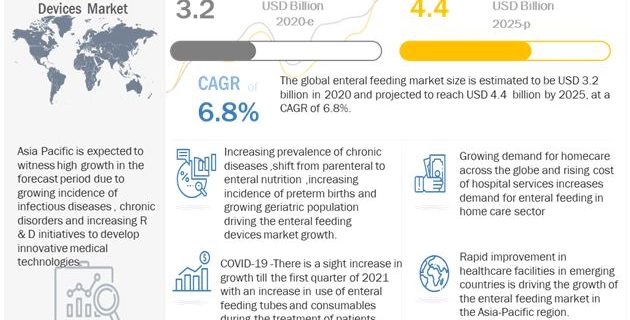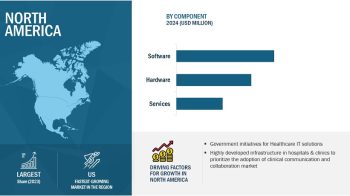
Key Factors Driving Growth in Enteral Feeding Devices Market:
The market
has evolved significantly owing to various technological advancements, such as
programming and safety features in feeding pumps as well as user-friendly and
portable feeding pumps. Factors such as rising healthcare costs; surge in the
number of preterm births; growth in the aging population; rising prevalence of
chronic diseases such as diabetes, cancer, gastrointestinal diseases, and
neurological disorders; growing awareness of enteral nutrition; and rapid
improvements in healthcare facilities in emerging countries are expected to
further drive the market during the forecast period.
What is the estimated growth of Enteral Feeding Devices Industry?
The enteral feeding devices market is projected to reach USD 4.4 billion by
2025 from USD 3.2 billion in 2020, at a CAGR of 6.8%.
Enteral Feeding Devices Market Dynamics: Impact Analysis
1. High Growth
Opportunities in Emerging Countries
2. Growing Demand for Enteral Feeding in the Home Care Sector
3. Increasing Prevalence of Chronic Diseases
Key
Questions Addressed in The Report:
1.
Who are the top 10 players
operating in the global Enteral Feeding Devices market?
2. What are the drivers, restraints, opportunities, and challenges in the
Enteral Feeding Devices Industry?
3. What are the opportunities for stakeholders and provide details of the
competitive landscape for key players?
4. What will be growth of Enteral Feeding Devices in North America, Europe,
Asia Pacific, Latin America, and the Middle East and Africa?
Download PDF Brochure:
https://www.marketsandmarkets.com/pdfdownloadNew.asp?id=183623035
Which Application Going to Dominate The Global Enteral Feeding Devices
Industry?
The
oncology segment accounted for the largest share of the global market. The
increase in the prevalence of various types of cancers, especially head and
neck cancers, cancers of the gastrointestinal system, lung cancer, and liver
cancer, is expected to play a major role in the higher adoption of enteral
feeding devices used to provide clinical nutrition to cancer patients.
Market Dynamics:
Driver: Shift from parenteral to enteral nutrition.
Enteral nutrition is more physiological, with fewer complications as
compared to parenteral nutrition. The major advantage of enteral nutrition is
the maintenance of the GI mucosal barrier, stimulating intestinal blood flow.
Enteral administration also helps in maintaining small intestine mass and
pancreatic functions, improves healing & recovery, reduces muscle
catabolism, and lowers the risk of infection and contamination. According to an
article published in the German Medical Science journal, major septic
complications affect only 3% of patients on enteral nutrition as compared to
over 20% of those on parenteral nutrition.
Opportunity: Emerging Countries
The Asia Pacific region is expected to offer potential growth opportunities
to market players in the coming years. This can primarily be attributed to the
diversified healthcare markets in this region, growing incidence of infectious
and chronic disorders, and increasing R&D initiatives to develop innovative
medical technologies. In addition, infrastructural developments in healthcare
facilities, increasing healthcare expenditure, and the low-cost manufacturing
advantage offered by emerging APAC countries are expected to encourage market
players to invest in this region in the coming years.
Request Sample Pages:
https://www.marketsandmarkets.com/requestsampleNew.asp?id=183623035
How North America to Dominate The Global Market:
North
America is expected to hold the largest market size in the market during the
forecast period, followed by the European region. The highest market share of
North America can be attributed to the high adoption of enteral feeding devices
among the aging population, increasing prevalence of chronic diseases, the
presence of many large hospitals, a shift from parenteral to enteral feeding,
and the development of innovative products. The presence of a large number of
global players in this region is another key factor contributing to the large
share of this market segment.

